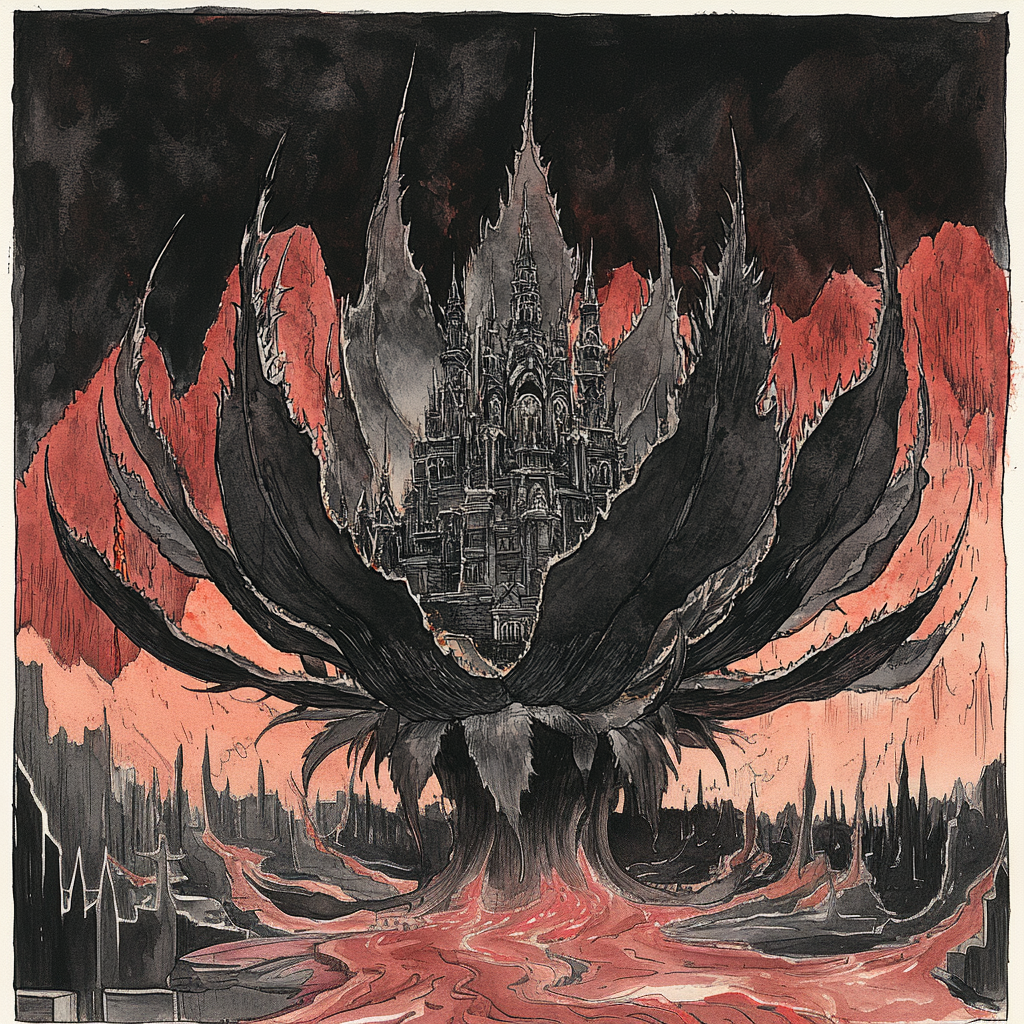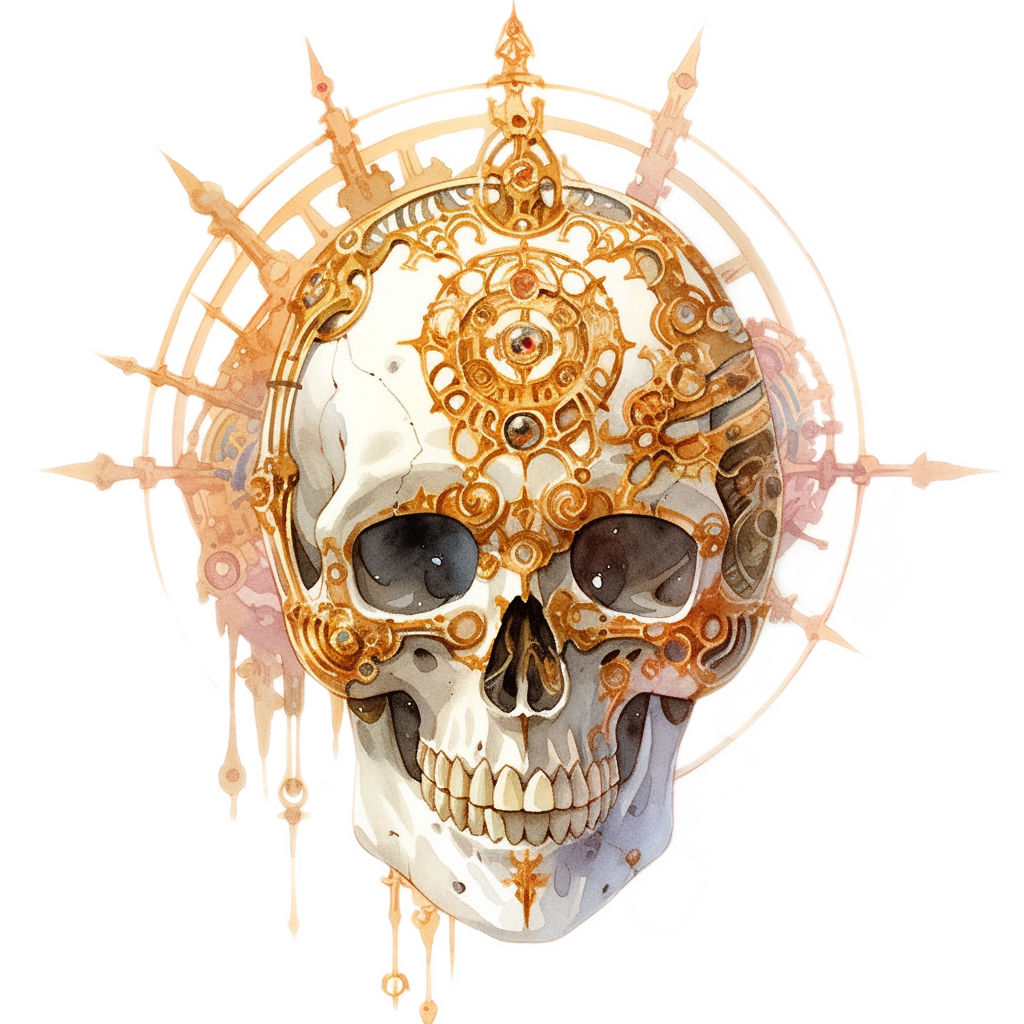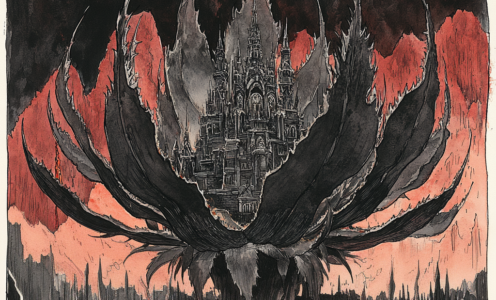The Flower Infernal

Bastion of the Tacharim
The Tacharim’s origins remain shrouded in deliberate obscurity, though graybeard scholars trace the formation of the organisation to the aftermath of the Blood War’s 227th Resurgence Cycle. Unlike most sects born from the brutal crucible of Gehenna that generally emphasise pure destruction, early Tacharim progenitors recognised the strategic advantage of combining the disciplined hierarchy of the baatezu with the vicious opportunism of Gehenna petitioners. This synthesis birthed a new dark doctrine, where loyalty to the group serves not as an absolute virtue, but as a pragmatic means to amplify a cutter’s individual power.
Located on one of the less accessible slopes of Khalas, the Tacharim headquarters combines the functionality of a fortress with psychologically-conditioning architecture. The peril of shifting lava flows all around prevents casual access to the structure. Called the Flower Infernal, the strange bastion erupts from Khalas’s smouldering slopes like a gargantuan black orchid fused with siege machinery. Its twelve obsidian petals—each a half-mile-long blade of living volcanic glass—can flex inward to form a spiked dome, their edges serrated and glowing faintly with absorbed geothermal energy. A moat of magma encircles the structure, fed by Gehenna’s volcanic fury, while the root plunges deep into the mountain, anchoring itself through a network of superheated tendrils. The air rising around the Flower shimmers with heat distortion, carrying the stench of sulfur and a metallic tang of modron ichor. The petals can be flexed outwards too, forming a bridge which traverses the lava rivers. At night, baleful green light pulses from within the fortress, casting jagged shadows across Khalas’ hellscape. Distant observers often mistake it for a brooding creature, its petals twitching as if breathing.
Beyond the razor-edged portcullis petals lies a biomechanical nightmare. The central chamber—a vertical shaft lined with retractable catwalks—connects to dozens of sub-chambers where Tacharim alchemists conduct their atrocities. Laboratories overflow with grafted modronoids chained to operating slabs, their hybridised limbs twitching involuntarily. Barracks carved from petrified plant matter house knights clad in armour fused with their skin, while geothermal vents power smelters that forge weapons from salvaged modron plating.
At the structure’s heart hangs the Seed Pod, a pulsating organic control hub where heat-sensitive mechanisms regulate the fortress’s defences. Every surface thrums with latent energy, and the walls occasionally bleed acidic sap to deter intruders.
Who Rules: Tacharim tradition mandates that leaders maintain position through a balance of fear and gratitude. The current hierarchy is led by three bloods, referred to as the Gauntlets. At least one of the Gauntlets is present in the Flower Infernal at any time.
- Xarxxes the Twelve-Scarred, the High Gauntlet (planar tiefling sorcerer [she/her] / Tacharim / LE). A warlord who survived twelve assassination attempts before age 30.
- Vryska the Silent, the Shadow Gauntlet (planar aasimar rogue [she/her] / Tacharim / NE). Master of intelligence gathering, rumoured to be a former Guardian, turned by something she learned in Belierin.
- Kroth Bonebrand the Iron Gauntlet (planar githzerai warrior [he/him] / Tacharim / NE). Siege warfare specialist who is currently planning an assault on Tradegate using several captured walking castles.
Rank advancement follows a “blood and ideas” system where promotions require both combat victories and tactical innovations. The current High Gauntlet rose to power after devising the now-standard “shadow caravan” tactic—disguising Tacharim raiders as merchant guards to infiltrate fortified settlements.
Spoiler for Dead Gods (click to expand):
The destruction of the Flower Infernal, stands as their most infamous defeat. This event culminated in a coalition led by Sir Vaimish Crasad, a paladin lord of Excelsior, who orchestrated a daring assault on the bastion. The knights exploited weaknesses in the Tacharim’s mercenary defences, using celestial artefacts to destabilise the fortress’s lava moats. The Flower Infernal’s collapse marked a temporary setback for the Tacharim, though their leadership survived by retreating into hidden outposts in the Outlands. The knights of Excelsior celebrated with a fete in their gate-town, but failed to eradicate the sect’s core hierarchy. While the conflict reinforced Excelsior’s reputation as a counterbalance to Outlands banditry, it also revealed the Tacharim’s resilience. The Black Knights later rebuilt their operations with enhanced elemental wards, incorporating fire-resistant homunculi bred by sect wizards.
Canonical Source: The Great Modron March [2e] p105
Source: Jon Winter-Holt


